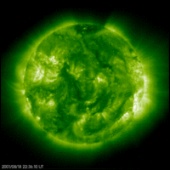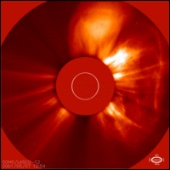ESA Science & Technology - News Archive
News archive
News archive
Ulysses has forever changed the way scientists view the Sun and its effect on the surrounding space. In the November 2008 issue of the ESA Bulletin Richard Marsden and Nigel Angold consider the epic voyage of this remarkable spacecraft.
Published: 31 October 2008
Data from the joint ESA/NASA Ulysses mission show that the Sun has reduced its output of solar wind to the lowest levels since accurate readings have become available. This current state of the Sun could reduce the natural shielding that envelops our Solar System.
Published: 23 September 2008
After more than 17 years of operation, the joint ESA/NASA mission Ulysses will officially conclude in July this year. The remarkable achievements of this mission were recalled at a press conference held at ESA Headquarters in Paris on 12 June.
Published: 12 June 2008
Published: 13 May 2008
Ulysses, the mission to study the Sun's poles and the influence of our star on surrounding space is coming to an end. After more than 17 years in space - almost four times its expected lifetime - the mission is finally succumbing to its harsh environment.
Published: 22 February 2008
Monday, 14 January, Ulysses passed another milestone as the spacecraft reached the highest north solar latitude in its orbit, passing over the Sun's north polar cap at about 80° N for the third time in its now more than 17-year long mission
Published: 15 January 2008
Meeting in Paris on 12-13 November, ESA's Science Programme Committee unanimously approved a proposal to continue operating the highly successful Ulysses spacecraft until March 2009. This latest extension, for a period of 12 months, is the fourth in the history of the joint ESA-NASA mission.
Published: 14 November 2007
With the Sun currently close to a minimum in its 11-year cycle of activity, Ulysses has detected remarkably energetic outbursts during the mission's third pass over the Sun's south polar region.
Published: 19 February 2007
Wednesday, 7 February 2007, Ulysses reached its maximum solar latitude of 80 degrees as it passed over the Sun's south pole, observing this extreme region for the third time in its more than 16 years of successful operations.
Published: 7 February 2007
On 17 November, the joint ESA-NASA Ulysses mission reached another important milestone with the start of the third passage over the Sun's south pole.
Published: 17 November 2006
More than 80 scientists from Europe and the US gathered in Oxnard, California, at the beginning of November to pore over the latest results from the Heliospheric Network, the international fleet of spacecraft studying the Sun and heliosphere, and to discuss its future.
Published: 15 November 2006
A team of European and American scientists has produced a series of results on the flow of interstellar helium atoms within the solar system. This flow is created by the Sun's motion inside the Local Interstellar Cloud of gas and dust.
Published: 20 September 2004
The highly successful Ulysses mission, with the aim of studying the high-latitude heliosphere, has been extended for a further four years. The decision was made at a meeting of ESA's Science Programme Committee in Paris.
Published: 12 February 2004
A Coronal Mass Ejection has caused a chance encounter of the Ulysses spacecraft with the ion tail of one and possibly two comets.
Published: 9 February 2004
Over the next few weeks, scientists on the joint ESA-NASA Ulysses mission will be turning their attention away from the Sun, and looking at Jupiter. In early February, Ulysses will approach the giant planet for a second time - 12 years after their first encounter.
Published: 29 January 2004
Observations by the DUST experiment on board Ulysses have shown that the stream of galactic stardust is highly affected by the Suns magnetic field. After the recent solar maximum, more dust is now expected to enter our Solar System.
Published: 1 August 2003
Published: 17 December 2001
Published: 11 October 2001
Published: 8 October 2001
Published: 19 June 2001
—
20 Items per Page

















